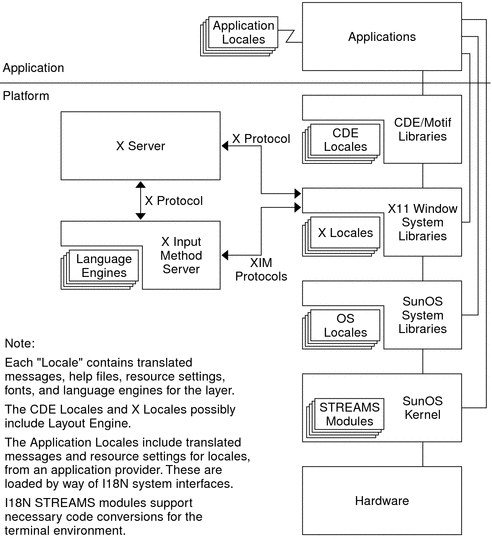Internationalization and Localization Overview
Internationalization and localization are different procedures. Internationalization is the process of making software portable between languages or regions, while localization is the process of adapting software for specific languages or regions. Internationalized software can be developed using interfaces that modify program behavior at runtime in accordance with specific cultural requirements. Localization involves establishing online information to support a language or region, called a locale.
Unlike software that must be completely rewritten before it can work with different native languages and customs, internationalized software does not require rewriting. The internationalized software can be ported from one locale to another without change. The Oracle Solaris system is internationalized, providing the infrastructure and interfaces you need to create internationalized software.
Basic Steps in Internationalization
An internationalized application's executable image is portable between languages and regions. To internationalize software:
-
Use the interfaces described in this book to create software with an environment that can be modified by dynamically recompiling.
-
Divide software into executable code and all the messages that the user might see. Keep the message strings in a message catalog.
Message strings are translated for a language or region. A locale includes the message strings and methods to specify sorting.
To use a localized version of a product, the user sets certain environment variables. The product then displays messages that are translated into the language of the locale. Date, time, currency, and other information is formatted and displayed according to locale-specific conventions. Message translations and online help contents are provided throughout different layers, as illustrated in the following diagram.
Figure 1–1 Functions and Structure of Locales in the Oracle Solaris operating system

Localization Functions in Oracle Solaris Interfaces
The OS (operating system) locale layer provides the basic locale database and functions that are plugged into the OS system interface at the application's runtime. Applications access these OS locale modules through standard APIs.
The X11 locale layer provides the interface to the X input method and X output method to X11 applications for local text input and display. Fonts enable applications to display characters from various languages.
CDE/Motif is built on top of the X11 window system. Hence, CDE/Motif can utilize the X11 locale capability through X11 APIs. Oracle Solaris localizations have various locale-specific configurations for CDE applications in order to make the desktop functional within the target locale. Message translations and online help contents are provided throughout different layers.
- © 2010, Oracle Corporation and/or its affiliates
